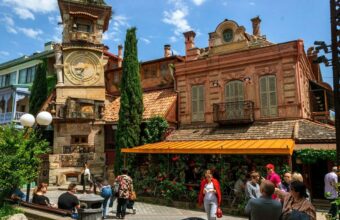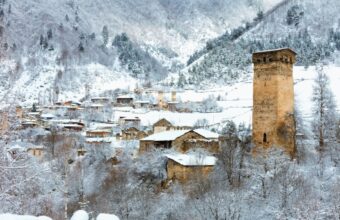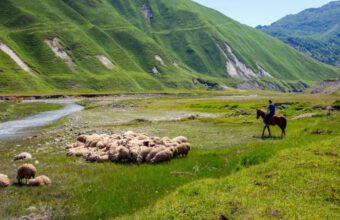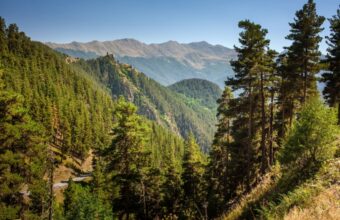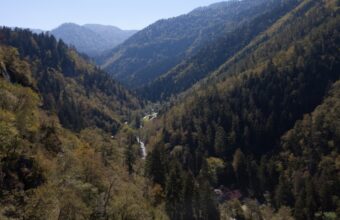Hiking in Georgia
An expert guide to the best treks in Georgia's Caucasus Mountains
Last updated 19 Mar 2024
With its picture-book landscapes, rolling hills and fairytale villages, hiking in Georgia's Caucasus mountains is a truly sublime experience.
Situated south of the Caucasus mountains, Georgia’s treks and hikes are suitable for most abilities and fitness levels. The country is well geared up for organised walking holidays with plenty of way-marked or guided walking routes, a good range of quality accommodation and, most importantly of all, some truly outstanding food to keep you well fuelled along the way.
For solo trekking, there are few restrictions on setting up camp while exploring the great outdoors, although some restrictions are in place in national parks and state nature reserves with designated camping and fireplace spots. Water is drinkable everywhere and you’re rarely far from a spring to fill up your water bottles.
The Georgia hiking season depends on the region and route. In the mountainous regions, the season starts from early summer and continues till early autumn. Winter in Georgia sees heavy snow that blocks roads and trails. Trekking in the winter is only available in national parks, but depends entirely on the weather conditions at the time.
Ready to go? Here's my essential guide on the best treks and hikes in Georgia.
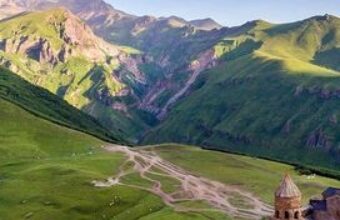
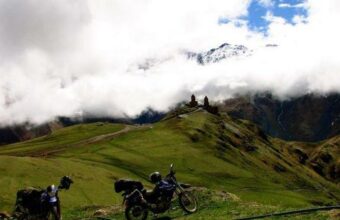
Georgia & Armenia Motorbike Tour
Visit the highlights of Georgia & Armenia on the road
16 days From £3,438 pp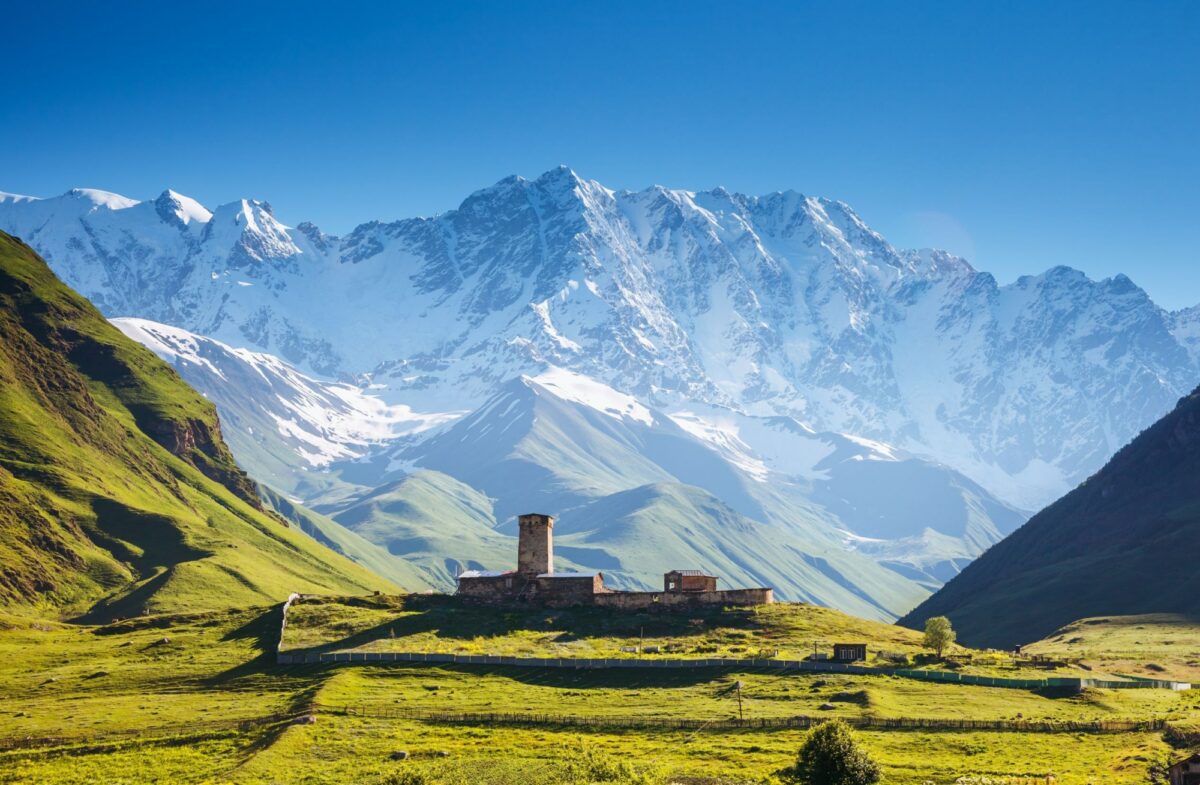
Classic Georgian scenery in Ushguli, Upper Svaneti UNESCO World Heritage Site
The best treks & hikes in Georgia
Where to go on a walking holiday in Georgie
-
Georgia
View trips -
Georgia
View trips -
Georgia
View trips -
Georgia
View trips -
Borjomi-Kharagauli National Park
View trips

Georgia
Mestia to Ushguli
- Distance: 60km (37 miles)
- Duration: Two to four days
- Start point: Mestia
- End point: Ushguli (can be hiked in reverse)
- Difficulty: Moderate – lots of climbs & descents with high elevations (max. 2740 metres)
The hiking trail from Mestia to Ushguli is one of the most popular multi-day walking holidays in Georgia. Best hiked in the summer months of July and August, the Mestia-Ushguli hike takes three to four days to complete.
The trek offers superb views and goes through several traditional villages in Georgia’s northwestern Svaneti region, with excellent home stays – so no tent required.
Facilities on this trek are as good as it gets for a remote mountainous region. Most of the lodges even have free wi-fi. In Mestia, you can also find apartments to rent. Hosts at home stays serve breakfast, dinner, and can even prepare lunchboxes for the road.
The first and last days of the trek are straightforward, but there are significant climbs and high elevations in between. The hiking trail is well marked and starts from Mestia's main square passing through forests, meadows, fields of rhododendrons, and villages adorned with typical Svanetian houses and defence towers. On your way, you have fantastic views of Mount Ushba (one of the Caucasus’ most notable peaks at an elevation of 4,710m) and the Svaneti Valley, full of wild orchids and views of imposing Mount Tetnuldi and the Adishi Glacier.
On the third day of the hike near Iprali village, hikers need to cross the Adishi river. In high season, locals offer horses to help travellers across the river. At other times, ask in the village about the water level and hire a horse if necessary. If you don't want to pay (or are scared of horses), walk around 50m upstream where the river branches out into several streams where you cross it on your own. The water is freezing, so wear hiking sandals and use sticks.
The last day of the hike takes you to one of the highest settlements in Europe and a UNESCO World Heritage Site – the village of Ushguli, found right below Mount Shkhara. Most hikers in Georgia follow the main road to Ushguli, which can get dusty from car traffic and can be a disappointing end to a rural hike. However, there's an alternative route that goes through the villages forming the Ushguli community. Once in Ushguli, stay overnight and visit the 12th-century Lamaria Church, once a devoted to a pagan Svan god of fertility. If you’re still after some trekking, you can walk to the imposing Shkara glacier (five hours) enjoying breathtaking views of the snow-covered mountains.
How to get to Mestia
The most common way to get to Mestia is taking a night train from Tbilisi to Zugdidi and then a marshrutka (a minibus) to Mestia. Marshrutkas to Mestia depart from Zugdidi train station daily. The first one leaves around 6:30am, right after the night train arrives. The last one leaves at 2:30pm. The journey takes approximately 3-4 hours, including a one hour break.
Alternatively, there's a flight from Natakhtari airport near Tbilisi, run by VanillaSky company. Be aware that flights get cancelled frequently due to poor weather conditions.
You can also drive to Mestia from Kutaisi. The direct marshrutkas leave from Kutaisi bus station behind McDonald's.

Georgia
Stepantsminda to Gergeti Glacier
- Distance: 20km (12 miles)
- Duration: Seven to eight hours
- Start point: Stepantsminda
- End point: Stepantsminda
- Difficulty: Challenging – a long day of pretty relentless climbing
Stepantsminda, also known as Kazbegi, is a popular destination for day or weekend walking trips from Tbilisi due to the graceful Gergeti Trinity Church found at the foot of Mount Kazbegi. Hiking to the Gergeti Glacier from Stepantsminda is a popular day hike passing by the church and Kazbegi.
The best time for this hike is from June till October.
In total, the trek takes around seven to eight hours from start to finish. Most hikers take five hours to climb the glacier and then come back to the village for another three. Even though this is a single day hike, be aware that you’ll gain more 1,500m in elevation. This is a tough walk, but the path is well marked and easy to follow. If you want to make the hike to Gergeti Glacier easier, you can take a taxi to Gergeti Trinity Church from Stepantsminda and start the hike from there.
It’s worth starting your Gergeti Glacier hike as early as possible. Mount Kazbegi is normally cloaked in clouds, so don't be fooled by bright, sunny morning. By 10am, Mount Kazbegi has "a cloud hat". Ideally, at this time you should be either at Gergeti Trinity Church or even higher.
There are several routes from Stepantsminda, but the best trail to take to the church is through the Bashli Valley, offering some fine views of the surrounding mountains. This route is a bit longer, but the incline is less steep and is away from car traffic. The track passes a ruined tower and follows the Bashi creek up to the church.
After getting to the church, the path continues towards the glacier through the birch forest to the Sabertse Pass. There are two options here, but the scenic route is the one that follows the ridge to the Sabertse crossing. Once there, you can explore a small shrine with a cross and enjoy a first look at the glacier. After crossing the metal bridge of the Chkheri river, the trail becomes steeper and climbs directly to the bottom of the glacier.
How to get to Stepantsminda
There are two ways to get to Stepantsminda – by marshrutka or a shared taxi. They both depart from Tbilisi's Didube Bus Station, located nearby the Didube metro station. A marshrutka is the cheapest – but least comfortable – way to get to Stepantsminda. Minibuses don’t leave until they are full, starting at 8am until late afternoon. The journey takes around 3-4 hours. Note that these are public transport meant for locals, so drivers don't stop at touristy spots along the Georgian Military Highway, except for a short toilet break.
Your best bet is taking a shared taxi. You can ask drivers to stop at iconic landmarks like Ananuti Fortress and the Georgia-Russia Friendship Monument along the way, giving you plenty of time to explore.
Read more
Georgia
Truso Valley to Kelitsadi Lake
- Distance: 28km (17 miles)
- Duration: Three days
- Start point: Truso Valley
- End point: Kelitsadi Lake
- Difficulty: Challenging – self-supported with wild camping
This picturesque and remote trek starts from the scenic Truso Valley, near the border with South Ossetia. Here, you can explore abandoned villages, ancient towers and mineral lakes. The route traverses the Keli volcanic plateau – an arid, rocky land situated west of the Georgian Military Highway. Few hikers come here as it's very close to the separatist territory of South Ossetia and the track is quite challenging. However, the highlight of the hike – crossing two 3,400m high mountain passes and the glacial Kelitsadi lake itself – make the trek worthwhile for hiking in Georgia.
The Truso Valley is around 20km from Stepantsminda. The trek starts from the sparsely-inhabited Kvemo Okrokana village and climbs up into the upper part of the valley. Look out for several mineral springs along the route, with some even forming pools of – icy – water you can swim in. Once in the valley, you see beautiful views of the opposing Mna gorge until you reach the rock-covered Keli plateau.
The trek takes three days. There are no proper camping spots or home stays, so you’ll be wild camping. Bring a tent, food, and water. As the trek crosses a volcanic plateau, there are few water sources. Make sure to have around 4-5 litres of water when leaving Kvemo Okrokana.
During the hike, you’ll pass the Higher and Lesser Khorisar volcanic peaks, until you reach the Khorisar Pass at 3,429m. The route is challenging so it’s worth taking a guide or GPS. From here, you should be able to see the White Aragvi River, which you’ll cross before descending to Kelitsadi Lake.
The hike towards Ketrisi village from Kelitsadi offers spectacular views of the Kazbegi massif, but strays very close to the South Ossetian border, so make sure you’re on the right route. The path continues into the Esi river valley and enters a small canyon with steep slopes. The village lies ahead after crossing the Esri river via a wooden bridge. Look for the monasteries and nunneries of Ketrisi, or take a short walk to the ruins of Zakagori Fortress.
How to get to Truso Valley
The entrance to the valley lies at Kobi village. Either ask the marshrutka driver to drop you off there or take a taxi to the Kvemo Okrokana village. Since 2018, Mountain Freaks, a travel agency, organises a bus from Stepantsminda to Kvemo Okrokana twice a day.
How to leave Ketrisi
The easiest way is to call a driver and arrange a pickup. Otherwise, walk out of the valley and stop any marshrutka to Tbilisi on the Georgian Military Highway.
Read more
Georgia
Tusheti to Khevsureti
- Distance: 78km (48 miles)
- Duration: Five days
- Start point: Omalo
- End point: Shatili
- Difficulty: Challenging
This spectacular five-day trek connects the regions of Tusheti and Khevsureti – starting from the village of Omalo and ending in Shatili.
Tusheti is one of the most stunning mountainous areas of Georgia, located just behind the main ridge of the Caucasus. Both areas are still unspoiled from tourists and commercial buildings due to poor roads, which also gives another charm to the whole trip.
The route is attractive not only for its nature but also for the traditional villages you’ll visit, which are dominated by stone towers that have stood since the Middle Ages. The trek follows a shepherd’s path connecting the regions. The first two days of hiking are spent on dirt roads connecting the villages of Tusheti, including Dartlo, one of the most well-preserved settlements in Tusheti, as well as abandoned towns with crumbling buildings. Afterwards, you'll continue walking towards Khevsureti through flat meadows, shepherds' shelters, the Atsunta Pass, with amazing views of Mount Tebulo. Eventually, you get to Khevsureti's ancient fortress of Mutso. From here, you continue your way towards Shatili Fortress. Make sure to stop by Anatori – House of the Dead – a place where inhabitants spent their last days during the plague of the 18th century.
The route is quite popular among travellers and hikers; it is also suitable for those who want to try a camping trip, but don't want anything too wild and remote. In terms of difficulty, the trek is somewhere between moderate and hard. You gain elevation slowly, but the track is 75km long and crosses a 3,400m-high pass.
Note that during this trip, you’ll pass several border checkpoints, where guards ask you to fill out registration forms for hiking in the border area.
How to get to Omalo
The only way to get to Omalo is by hiring a driver with 4WD. First, you need to get to Telavi or Kvemo Alvani village from Tbilisi either by a shared taxi or a marshrutka. Drivers are used to hikers and tourists heading to the region, so they can help you arrange the drive to Omalo. The drive to Omalo takes around 4-5 hours through the winding Abano Pass road.
How to leave Shatili
Marshrutkas from Shatili to Tbilisi leaves every Thursday and Sunday at noon. In high season they often get full, so buy tickets in advance.

Borjomi-Kharagauli National Park
Hiking in Borjomi-Kharagauli National Park
Borjomi-Kharagauli National Park, located in central Georgia, spans 107,083 ha of land and covers six districts, with plenty of hiking trails offering scenic panoramas.
This park is the first of its kind in Georgia to comply with international standards for national parks, meaning every trail is well marked apart and their are designated areas for tents, fires and picnic areas. Trekking here involves staying either at the tourist shelters or putting up a tent. It is possible to go hiking in Borjomi-Kharagauli National Park in every season except summer, as it gets far too hot.
The best way to get to the national park is to take a marshrutka from Tbilisi to Borjomi. The journey takes around two hours. From Borjomi, take another marshrutka towards Likani and ask your driver to drop you off at the park’s administrative centre.
Twelve well-marked hiking trails provide single or multi-day hikes. Try some of the following:
Nicholas Romanov's Trail
The path goes through coniferous forests leading to Lomi Mountain and St George Church, with spectacular views of the Caucasus mountains. This moderately challenging trek takes three days with 43km long route.
St Andrew’s Trail
This difficult 4-day trek takes you to the highest peak of the National Park, called Sametskhvario (Shepherd’s Place). On your way, you pass through sub-tropical forests and alpine meadows, enjoying spectacular views of Mt Iron Cross.
Panorama Trail
The Panorama Trail is one of the most beautiful treks in Borjomi-Kharagauli National Park. It is a two-day, 34km long circular trail with stunning views and the chance to see wildlife including bears and wolves. You can visit the shepherd’s huts near the hiker huts to learn more about this challenging job.
Footprint Trail
This one-day moderately challenging trek is famous for the ancient yew trees you’ll pass, some of which are centuries-old. The winding path crossing mountain slopes through to Kvabiskhevi canyon.
The Snow Shoes Trail
This is one of the most popular trails, winding through evergreen forests covered in snow. The total length of the path is 15.5km and takes two days to finish. The route starts and finishes at the Likani guard station and follows the mountain ridge, with views of Mount Lomis Mta.
Read moreAbout the author
Baia Dzagnidze
Baia is a travel writer and blogger from Tbilisi, Georgia. With a background in journalism, she has been writing travel articles about Georgia for local and international publications for more than three years. Her articles have been published in Lonely Planet, National Geographic Traveller FOOD (UK edition), Skyscanner, Georgia Starts Here, and Forbes Woman Georgia.

